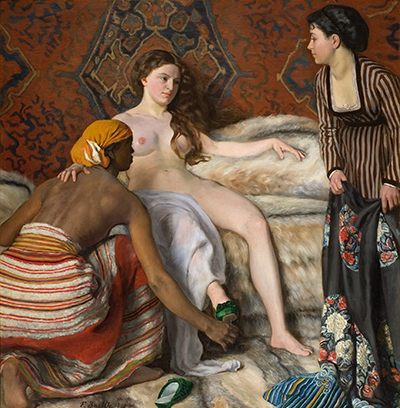La Toilette by Jean Frederic Bazille, a French artist, was one of his last works before he was killed in active service in the Franco-Prussian war. The painting was produced between 1869 and 1870.
The painting was unfortunately rejected for display by The Salon gallery at Paris, despite their enthusiasm for displaying some of the artist's other work. It is thought that they didn't find it inspirational or remarkable, rather than any concern about the content. The painting is an oil on canvas, 132 cm by 127 cm, and is on display in the Musee Fabre in Montpelier, the artist's home town in France. The painting depicts a young woman, presumably wealthy, being assisted to undress two maids, servants or slaves. The woman is partially covered by a garment or towel and her hair, so that despite being naked, only one of her breasts is exposed and the rest of her dignity is preserved.
The woman portrayed does no appear to be paying attention to the women assisting her, but seems to have her mind on other things. She is well-shaped, with curves but no fat, and an elegant neck, she has pale skin, long brown hair and dark eyes. An African woman barefoot and dressed in a coloured striped half-robe and yellow turban is kneeling beside her, removing her green shoes, and although she is not paying attention, she has her hand on this woman's shoulder. She is simply lying there and being undressed and prepared for a bath or dressing in another outfit. The content of this painting will remind many of Edouard Manet paintings.
In front of the woman portrayed, there is the other helper, dressed in a brown striped dress and wearing a hairnet, and holding a garment of black silken material with coloured patterns, there is another garment at her feet. The woman at the centre of the picture is lounging on a fur covered couch, and has furs at her feet. The wall behind her is orange-brown and dark mosaic patterned. She has a cloth or towel draped over her right leg and thigh, hiding her groin, and her hair falls over her shoulder, covering her left breast, leaving just one breast on view and the rest possibly to imagination. The painting appears to consider status as well as female form and position, and may make the viewer consider what the women are thinking.




